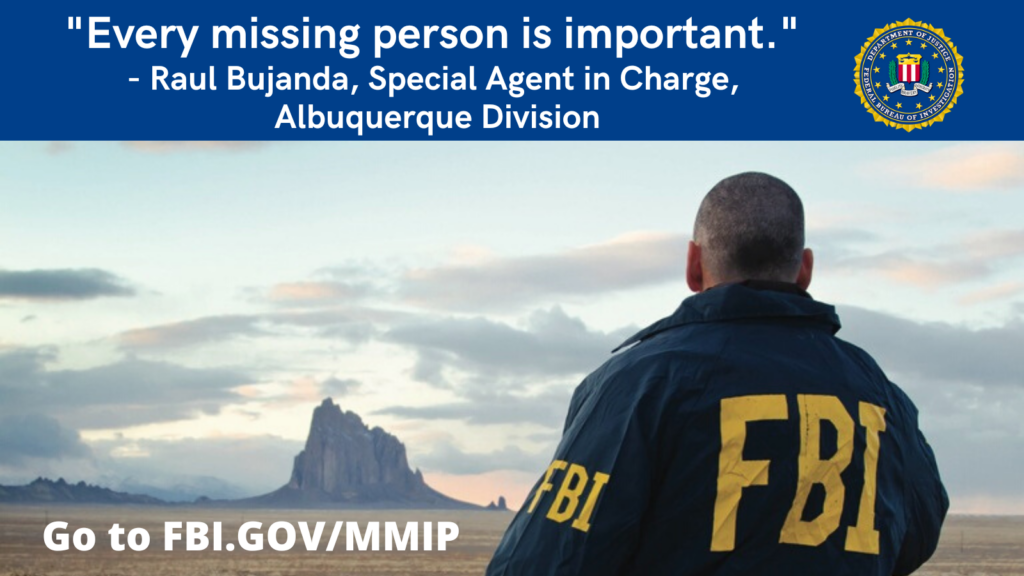
The FBI, in an effort to address the crisis of missing or murdered Indigenous persons, is releasing a list of more than 170 Native Americans it has verified as missing throughout New Mexico and the Navajo Nation.
This effort is being publicized to help locate these individuals, increase transparency, and to encourage relatives of missing Indigenous persons who are not on this list to reach out to local law enforcement and file a report.
A link to the list can be found at FBI.GOV/MMIP.
“Every missing person is important. For a long time, the issue of missing Native Americans has been in the news and a lot of people have been wondering if anybody is paying attention,” Special Agent in Charge Raul Bujanda of the Albuquerque FBI Division said. “I am here to assure you the FBI has been paying attention, and together with our partners, we are taking a significant step towards justice for these victims, their families, and communities.”
The release of the list is the result of almost six months of work combining and validating different databases of missing Indigenous persons in New Mexico.
“We will meet the case of each missing and murdered indigenous person with urgency, transparency, and coordination,” said Alexander M.M. Uballez, United States Attorney for the District of New Mexico. “Everyone deserves to feel safe in their community, and the development and implementation of this list marks a promising step forward in the investigation and resolution of these cases.”
“It is important that we work together to find resolution for those who are missing and their families,” said Marcelino ToersBijns, unit chief of the Missing and Murdered Unit at the Bureau of Indian Affairs Office of Justice Services. “This single-source data set is an important improvement in information sharing that demonstrates how BIA and federal, tribal, state, and local law enforcement agencies in New Mexico and the Navajo Nation are working together to address this horrible crisis.”
FBI validated the status of missing Indigenous persons as listed in the National Crime Information Center (NCIC), a computerized system of criminal justice information available to federal, state, local, and tribal law enforcement, and other criminal justice agencies.
Many records of missing Indigenous persons were incomplete or outdated because the record was not updated once additional details were made available or once the person was located.
The FBI vetted hundreds of files and arrived at more than 170 cases of Native Americans in New Mexico who have been verified as missing. The list includes all missing Indigenous persons within New Mexico, but it also includes the Navajo Nation, which crosses into New Mexico, Arizona, and Utah. The FBI plans to update the names monthly.
Partners involved in the project include the U.S. Attorney’s Office, Bureau of Indian Affairs Office of Justice Services, New Mexico’s Missing and Murdered Indigenous Women and Relatives (MMIWR) Task Force, New Mexico Attorney General’s Office, New Mexico Department of Public Safety, New Mexico Department of Indian Affairs, Bernalillo County District Attorney’s Office, and the City of Albuquerque Office of Equity and Inclusion.
As part of this effort, the FBI received information and support from the Navajo Nation, Native American pueblos, and local law enforcement.
“The FBI resources and manpower dedicated to producing this validated list of missing Indigenous persons across New Mexico is critical to define the true scope of MMIWR in the state,” said New Mexico Indian Affairs Department Secretary Lynn Trujillo, Chair of the MMIWR Task Force. “The data shared today will guide the state’s response to this ongoing crisis. The task force will continue strengthening partnerships across all levels of government, including grassroots organizations that are on the ground providing direct support to families and communities.”
“This is an important step among many, and this multiagency effort is crucial to provide justice and victim services to communities that have historically been underserved,” said New Mexico Attorney General Hector Balderas.
“The New Mexico Department of Public Safety is the first agency in the United States to modify its National Crime Information Center (NCIC) Missing Person Form to allow reporting agencies to identify Indigenous people and their respective tribes, pueblos, or nations,” said New Mexico Department of Public Safety Secretary Jason R. Bowie. “We intend to find answers and justice for these women and families in our community. For generations, a disproportionately high number of missing and murdered indigenous women and relatives have gone unreported. We resolve to address and prevent further tragedy in our state; everyone deserves to feel safe in their neighborhoods.”
“We appreciate the FBI’s work to vet and refine the list of reported missing Indigenous persons. Our MMIWR Unit, created in December of 2021, will use the advanced investigative techniques that have already helped solve two cases to follow-up on leads generated from this list,” said Bernalillo County District Attorney Raúl Torrez. “We encourage relatives of missing Indigenous persons who are not on this list to reach out to local law enforcement. Our office stands ready to work with you.”
If someone’s relative is included in the names, the FBI is actively checking numerous law enforcement databases and other sources nationwide to identify leads that will be quickly passed along to the appropriate agency.
If an Indigenous family member who is missing is not included in this list the relatives are urged to contact their local or tribal law enforcement agency and ask them to submit a missing person report to NCIC. For further assistance with their request, family members or local law enforcement can contact the New Mexico Attorney General’s Office or the FBI.
This project is in addition to the FBI’s continuing efforts to call attention to unsolved Indigenous homicides and missing person cases it is investigating.